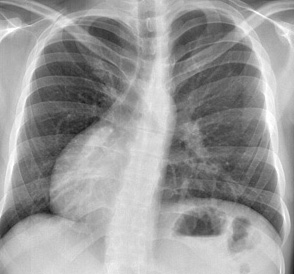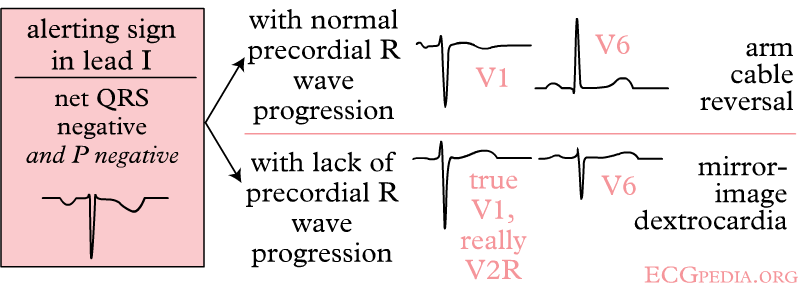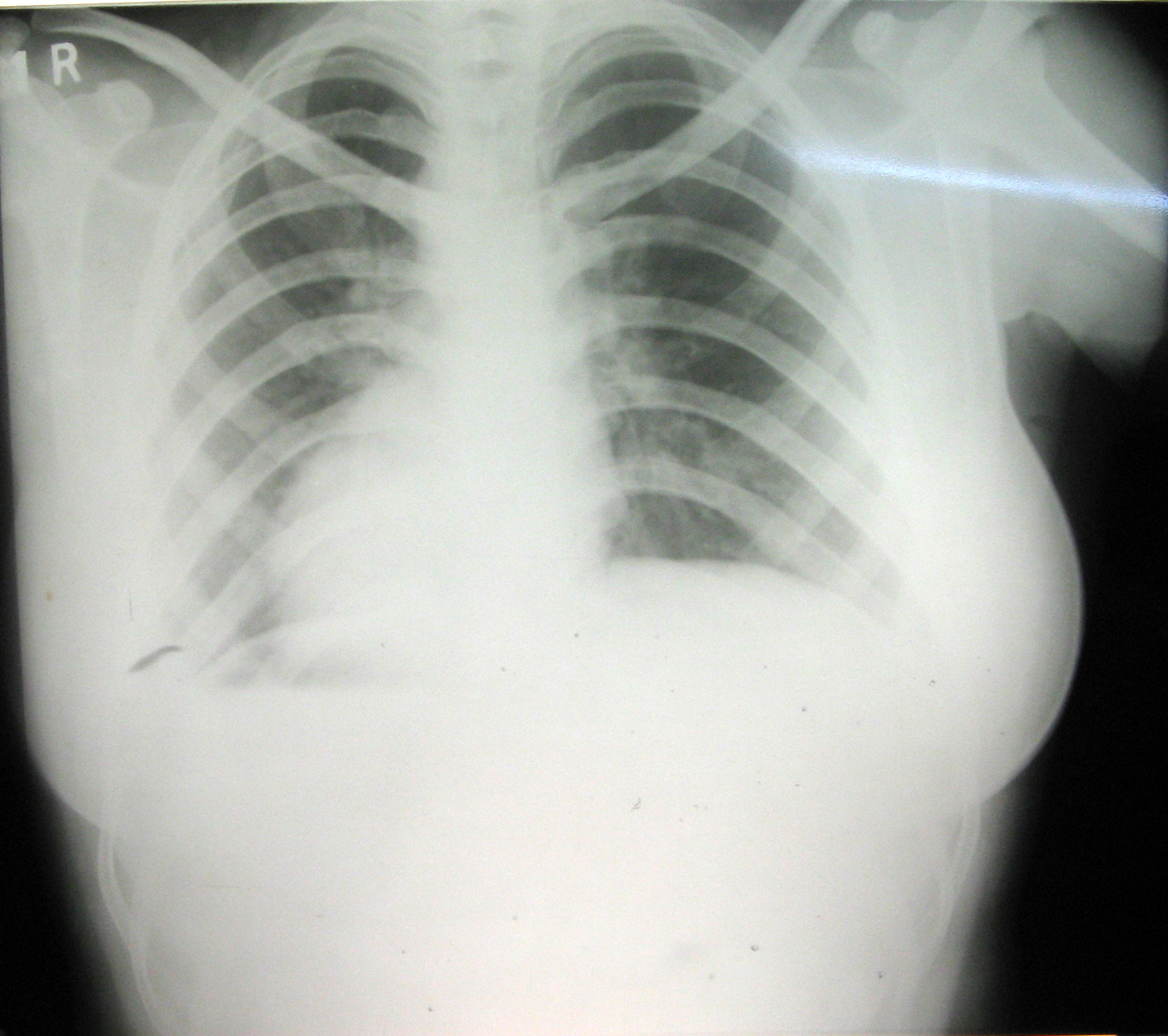Dextrocardia
| Dextrocardia | ||
 | ||
|---|---|---|
| ICD-10 | Q24.0 | |
| ICD-9 | 746.87 | |
| DiseasesDB | 3617 | |
| MeSH | C14.240.400.280 | |
| Cardiology Network |
 Discuss Dextrocardia further in the WikiDoc Cardiology Network |
| Adult Congenital |
|---|
| Biomarkers |
| Cardiac Rehabilitation |
| Congestive Heart Failure |
| CT Angiography |
| Echocardiography |
| Electrophysiology |
| Cardiology General |
| Genetics |
| Health Economics |
| Hypertension |
| Interventional Cardiology |
| MRI |
| Nuclear Cardiology |
| Peripheral Arterial Disease |
| Prevention |
| Public Policy |
| Pulmonary Embolism |
| Stable Angina |
| Valvular Heart Disease |
| Vascular Medicine |
|
WikiDoc Resources for Dextrocardia |
|
Articles |
|---|
|
Most recent articles on Dextrocardia Most cited articles on Dextrocardia |
|
Media |
|
Powerpoint slides on Dextrocardia |
|
Evidence Based Medicine |
|
Clinical Trials |
|
Ongoing Trials on Dextrocardia at Clinical Trials.gov Clinical Trials on Dextrocardia at Google
|
|
Guidelines / Policies / Govt |
|
US National Guidelines Clearinghouse on Dextrocardia
|
|
Books |
|
News |
|
Commentary |
|
Definitions |
|
Patient Resources / Community |
|
Patient resources on Dextrocardia Discussion groups on Dextrocardia Patient Handouts on Dextrocardia Directions to Hospitals Treating Dextrocardia Risk calculators and risk factors for Dextrocardia
|
|
Healthcare Provider Resources |
|
Causes & Risk Factors for Dextrocardia |
|
Continuing Medical Education (CME) |
|
International |
|
|
|
Business |
|
Experimental / Informatics |
Editor-In-Chief: C. Michael Gibson, M.S., M.D. [1]
Associate Editor-in-Chief: Keri Shafer, M.D. [2]
Please Join in Editing This Page and Apply to be an Editor-In-Chief for this topic: There can be one or more than one Editor-In-Chief. You may also apply to be an Associate Editor-In-Chief of one of the subtopics below. Please mail us [3] to indicate your interest in serving either as an Editor-In-Chief of the entire topic or as an Associate Editor-In-Chief for a subtopic. Please be sure to attach your CV and or biographical sketch.
Overview
'Dextrocardia refers to the heart being situated on the right side of the body. If all visceral organs are mirror reversed, the correct term is Dextrocardia Situs Inversus Totalis. Individuals with both dextrocardia and situs inversus have a lower incidence of congenital heart defects than do people with only one of the two conditions.
History
Dextorocardia was decribed by Fabricious in 1606. Situs inversus with dextrocardia (totalis) was first described by Severinus in 1643.
Epidemiology
Dextrocardia is believed to occur in approximately 1 in a 100 people, while 1 in 1,000 of these will have Situs Inversus.
Kartagener’s syndrome occurs in approximately 1 in 15-25 of patients with Totalis (situs inversus with dextrocardia). Kartagener Syndrome (KS), is a rare autosomal recessive genetic disorder caused by a defect in the action of the tiny hairs (cilia) lining the respiratory tract. Specifically, it is a defect in a gene coding for left-right dynein (lrd), a key structural protein in cilia.[1]
Pathophysiology
Dextrocardia is not associated with any medical sequela.
Diagnosis
Electrocardiogram
It is possible to distinguish lead reversal and dextrocardia by watching the precordial leads. Dextrocardia will show an R wave inversion, whereas lead reversal will not. The bottom EKG shows marked right axis deviation and loss of voltage across the precordium. There are also inverted P waves in leads I and aVL. The differential for inverted P waves in lead I and aVL is Dextrocardia vs Reversed Arm Leads. Since there is loss of voltage across the precordium this is Dextrocardia.
-
Right and left arm lead reversal can be distinguished from the (much rarer) dextrocardia by looking at the precordial R wave progression.
-
EKG in a patient with dextrocardia. This EKG shows marked right axis deviation and loss of voltage across the precordium. There are also inverted p waves in leads I and aVL. The differential for inverted p waves in lead I and aVL is Dextrocardia or Reversed Arm Leads. Since there is loss of voltage across the precordium this is Dextrocardia.
Chest X Ray
Shown to the right is a chest X ray in a patient with Dextrocardia. Note that the heart is on the right side of the chest.
Coronary Angiography
- Dextrocardia Angiogram 1
<youtube v=r570-FIuVCc/>
- Dextrocardia Angiogram 2
<youtube v=Kd1LjLJWvTQ/>
- Dextrocardia Angiogram 3
<youtube v=rIQqCAgLk1Y/>
Fetal and Postnatal Diagnosis by Ultrasound, Magnetic Resonance Imaging (MRI), and Chest X Ray
The presenting twin of this 22 week gestation has dextrocardia. Images supported by NIH grant NS37945
Performing an EKG
ECG leads must be placed in reversed positions on a person with Dextrocardia.
Defibrillating a Patient with Dextrocardia
When defibrillating a patient with dextrocardia, the pads should be placed in reverse positions. That is, instead of upper right and lower left, pads should be placed upper left and lower right.
Treatment
Coronary Artery Bypass Grafting
CABG can be performed in the patient with dextrocardia. A right internal mammary artery may be used as a conduit to the left anterior descending artery.[2] [3] [4]
References
- ↑ Cleveland JC Jr, Shroyer AL, Chen AY, et al: Off-pump coronary artery bypass grafting decreases risk-adjusted mortality and morbidity. Ann Thorac Surg 2001;72: 1282-1289.
- ↑ Irvin RG, Ballenger JF: Coronary artery bypass in a patient with situs inversus. Chest 1982;81:380-381.
- ↑ Mesa JM, Aroca A, Frutos A, et al: Situs inversus and myocardial revascularization: Case report. J Cardiovasc Surg 1995;36: 571-572.
- ↑ Cleveland JC Jr, Shroyer AL, Chen AY, et al: Off-pump coronary artery bypass grafting decreases risk-adjusted mortality and morbidity. Ann Thorac Surg 2001;72: 1282-1289.
Additional resources
Additional Reading
- Moss and Adams' Heart Disease in Infants, Children, and Adolescents Hugh D. Allen, Arthur J. Moss, David J. Driscoll, Forrest H. Adams, Timothy F. Feltes, Robert E. Shaddy, 2007 ISBN 0781786843






